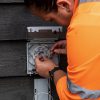First Hints of New UK Gov Measures to Tackle Broadband Pole Complaints

The UK Government will shortly attempt to deliver on their pledge to “end the deployment of unnecessary telegraph poles” (here) by publishing an updated Code of Practice for broadband operators to follow, which will set out new guidance on the divisive issue. We now have a good idea of what that new code will include.
Just to recap. The deployment of poles (usually made of wood or metal) to run overhead fibre is a common practice (over 4 million have already been built). This is because they’re quick and cost-effective to build (several times cheaper than trenching), can be deployed in areas where there may be no space or access agreement to safely put new underground cables, are less disruptive (avoiding the noise, access restrictions and damage to pavements of street works) and can be built under Permitted Development (PD) rights with only minimal prior notice.
The previous government, driven by its targets for expanding gigabit-capable broadband infrastructure, even facilitated such deployments by cutting red tape to help make the work as easy as possible. This has contributed to the currently rapid roll-out of Fibre-to-the-Premises (FTTP) based gigabit broadband networks across the UK, which can now be done in a much more cost-efficient way.
Advertisement
On the flip side, not everybody is a fan of poles (particularly those living in areas that haven’t had them before), which has caused a sharp rise in complaints and protests from residents in various parts of the UK. The complaints usually highlight their negative visual appearance, as well as concerns about exposure to damage from major storms, a lack of effective prior consultation, duplication of existing infrastructure or engineers that fail to follow safety rules while building etc.
In response to this the government has been working with network operators to “revise” the existing Code of Practice (linked above) in a way that would, as Sir Chris Bryant (Telecoms Minister) put it, require providers to “pay greater attention to the communities’ concerns” and to build underground wherever possible (operators already do this as it’s the most cost-effective approach, albeit only when available to them).
On top of that, they’ve also been supporting a push for greater infrastructure sharing, such as via INCA’s project (here and here).
What’s in the new code?
Until the new code is published, which is expected very soon, we won’t know the exact details. But ISPreview has spent some time speaking to our industry sources, and as a result we now have a rough idea of what to expect when the code is finally published.
Advertisement
The first draft version of the updated Code was presented, through the industry-wide Poles Working Group (jointly run by INCA and the ISPA), to the government just before Christmas and network operators have since been working through the Telecoms Minister’s comments on that. A revised document is then expected to be presented to the Minister in the “next few weeks” and regular meetings have also been taking place at other levels of government (DSIT).
The revised code, as currently drafted, is not expected to deliver any major changes, but it will focus on ensuring that network operators communicate better with communities (identifying areas where this is needed). The Code is also expected to be presented alongside a bigger push for infrastructure sharing between alternative network operators (see the links to INCA’s project above).
Furthermore, the new Code will introduce clearer rules on where not to site poles, as well as guidance on what to do with pole complaints and where re-siting is appropriate. On top of that, the Code will include an industry commitment to consider pole impact during the planning and installation stages, as well as a commitment to consider utilising existing poles.
Sources have informed ISPreview that Sir Chris Bryant appears to be seeking an outcome that would result in no more pole complaints, which operators broadly view as being “unrealistic” in the current climate of rapid network build. Plenty of questions also remain over how the changes will be enforced (i.e. Ofcom have very limited powers in this area) and key points are still subject to change.
Advertisement
On the issue of infrastructure sharing, INCA’s Infrastructure Sharing Group (ISG) recently produced a first draft of a new sharing framework, which is still being reviewed by its members and is expected to launch toward the end of this quarter. The scope of this is understood to have been narrowed to look at sharing non-Openreach poles, rather than ducts, but the exact details are still being refined.
The government clearly have a difficult balancing act to perform. On the one hand, they need to ensure that the concerns raised by various communities are not simply ignored and have some impact, while on the other hand they must avoid implementing any measures that might risk damaging the wider roll-out and cost models. The latter would risk their ambitions for making a “renewed push to fulfil the ambition of full gigabit and national 5G coverage by 2030” (here).
Mark is a professional technology writer, IT consultant and computer engineer from Dorset (England), he also founded ISPreview in 1999 and enjoys analysing the latest telecoms and broadband developments. Find me on X (Twitter), Mastodon, Facebook, BlueSky, Threads.net and Linkedin.
« Rights Holders Move Closer to Imposing Website Blocks on VPN Providers






















































The government should give the money to put the cables underground. I mean I understand stand money is tight
“The government should give the money to put the cables underground.”
Whose money is that?
THere is no spare cash. The government is having to impose cuts across all Whitehall departments.
“Sir Chris Bryant appears to be seeking an outcome that would result in no more pole complaints”
No chance unless poles are not used at all and then people will just complain about ducts and their cabinets.
Infrastructure sharing, other than with the former public monopoly, is an interesting one. Is it fair for small altnets to borrow and invest in the infrastructure only for others to come along and use it with much lower debt/investment burden and thereby offer lower prices? It could lead to some areas not getting service at all or long delays if nobody is willing to make the first move.
The alternative could be to create a single company that takes purchases ownership of all passive infrastructure then leases it back to all network operators, any infrastructure that any network builds will then be added as well. I do appreciate this would be far easier said than done.
Sharing infrastructure does not necessarily mean that the original owner of the infrastructure cannot be remunerated.
Though that does itself open more questions: who sets the level of the rental fee? If it is the infrastructure owner, then they could set it so high as to price out competitors, and if it is an independent body, eg OFCOM, then they might set it a lot lower, (to encourage take-up), than the owner thinks makes investing viable.
.
Why should BT Openreach be expected to cover the costs of allowing access to its infrastructure. The requirement to provide shared access should apply to all providers.
Openreach are in a special position because a) they’re largely not building new infrastructure they’re running fibre through ducts and poles that have existed for decades and the costs long since recovered, and b) most of those ducts and poles were paid for by tax payers.
@ john:
The AltNets are building infrastructure where it has not existed before. BT, like all providers, should have reciprocal access rights to all infrastructure. Much of the problem with a lack of alternatives in the UK is due to BT’s competitors not putting money into building their own networks for a couple of decades.
“Plenty of questions also remain over how the changes will be enforced (i.e. Ofcom have very limited powers in this area)”. Well give them those powers and ensure they use them. There are too many organisations in this country filled with a bunch of grifters whose sole purpose is to pass the buck.
Such as?
Sharing of Ducts would help. At the moment Openreach has to share with other providers, but there doesn’t seem to be retrospective rights. So if a new estate had been built with Virgin Media, Openreach [or altnets] aren’t allowed to use VM ducts.
That little change would probably make some benefit for everybody.
It would act to dissuade operators from building physical infrastructure. It makes far more financial sense to just wait for someone else to build and then lease space from them. It would result in a slowdown in fibre rollout.
@84.08khz
The provider would have to build the infrastructure as a condition of being given the contract.
It needs to cover carrier poles. One here has 8 fibre cables to a main pole and 7 to the next. Due to Openreach and 2 altnets.
The poles are capable of carrying far more.
Be great if the reception in rural areas was improved
The same people who squawk about poles were the same sort as complain about the wrong colour of concrete/tar when ducts are laid under pavements and roads.
The trouble with modern Britain is that there are way too many over empowered people who are just moaning Minnys.
You’re probably right but how hard is it to order and lay the right colour v. the wrong colour? Not to mention taking a bit of pride in your work and doing a good job rather than a quick bodge. Everything gets done on the cheap.
My guess is he doesn’t mean the wrong colour, what he means is the existing tarmac will be old and faded and the trench fill will have shiny new tarmac, so they’ll complain the colours are different…
I’m one of those moaning minny’s against the unnecessary duplication and triplication of telegraph poles in many streets in Hull and many surrounding towns and villages when there could have been infrastructure sharing with the incumbent KCOM. It is possible the first trial sharing area is in Wawne near Hull . It is only pressure on the industry that has resulted in this trial
I don’t think any of us moaning Minny’s are against the installation of Necessary infrastructure to upgrade to deliver FFTP gigabit capable where no infrastructure exists
These changes of codes of practise , infrastructure sharing need to be robust to halt overbuild and as many have said OFCOM need the powers to regulate its own industry
Even now you still think that the companies turned down infrastructure sharing with KCOM and now think your campaign forced them to start using KCOM equipment. It’s totally backwards and arse about face.
MS3 have been trying to use KCOM plant for fibre deployment since the 2010s via requests carrying full legal effect as requests to access the infrastructure compliant with the law. Government pressure on KCOM, not the altnets, made KCOM start a trial.
KCOM know they’re getting PIA regulations put on them in the next review. This is entirely about pressure being put on KCOM. The costs, terms and conditions they put in place to use their network with printed maps marked up, not digital, babysitters present at high cost while a customer works on a pole or duct to make sure they meet standard. Then the checking of the work, chargeable and expensive, when done. This had to become something more reasonable. That’s what they are offering.
Pressure seemed to be applied by the altnets and the government on KCOM. Your campaign was very, very, very soft on KCON as I recall, barely mentioned and blamed for virtually nothing by yourself and Julie on the whole.
They need to do something about drop wires too that come across people’s front gardens to neighbouring properties. BT Copper (currently left after ALTNET installed their fibre), so that’s two cables. Now the neighbour is likely to want Openreach Fibre at some point, that becomes 3 cables. Presently, the house presented in this example, just has Virgin Media at ground level entry, but the owner would like to go to an ALTNET and then later BT/Openreach so that is 2 drop wires – so one property servicing just one neighbour now has 5 drop wires running outside their front bedroom windows! They’d be more if the current owner also had a legacy copper cable in situ as well.
Supposedly, the cables are to be at least 2 metres away from any part of the house if they are feeding other properties, but I can tell you that many examples, including an installation by YouFibre last week aren’t and that they left the copper cable up, which Openreach now allow removal.
First World problems.
If you live in the third world of rural Britain you have no such concerns as only copper is available, probably from 1960s.
How many of the 4 million poles have been added exclusively for FTTP?
The suggestion of a shared system of ducting sounds best, combine the BT/virgin cabinets and then it’s a simple fibre patch cable in the cabinet to whoever’s providing the service.
Make it mandatory to lay tubes under every pavement and remove poles slowly, underground fibre should never fail or need replacing as hung fibre will wear and break over time in wind and physical damage.
The switching gear might be upgraded but the customer would never need to know.
Underground fibre will still get damaged, ducts fail, full with sediment and get dug up inadvertently. Should be less damage than overhead, but also can be slower to fix as fault is more hidden
30 years too late for that. Mandatory for who?
They need to do something about companies installing ‘Street Furniture’ – City Fibre delight in installing numerous small green cabinets (1 per 50 houses) where as BT/Open reach are removing theirs; Gigaclear are doing the great majority of their distribution Underground (1 grey cabinet located discretely for 1800 houses).
Do cityfibre have to pay any upfront cost / rent to the council for their street furniture?
Any additional conditions imposed on the deployment or upgrade of infrastructure required to support the roll-out of Ful Fibre will cause providers to miss the government targets.
Another Labour growth initiative. Joke.
Truespeed appeared in the street outside our property to install FTP to a neighbour via existing BT duct, only to find blockage. Returned over weekend and installed new duct. A few weeks later Openreach arrived, being ex BT went out for chat explained Truespeed had issues. Was surprised to hear Openreach cannot duct share using Treespeed!